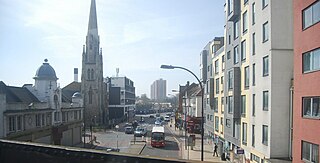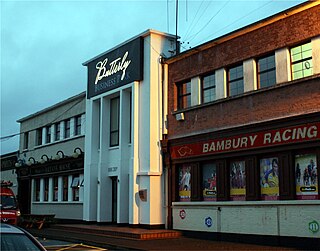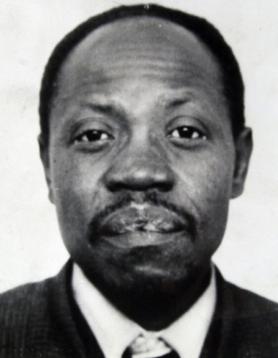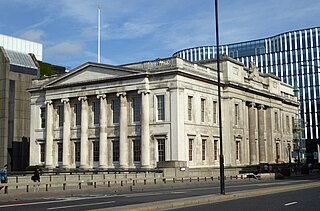| Date | 18 January 1981 |
|---|---|
| Location | New Cross Road, New Cross, south-east, London, United Kingdom |
| Type | Fire |
| Deaths | 13 (direct); 1 (suicide) |
The New Cross house fire was a fire that occurred during a party at a house in New Cross, south-east London, in the early hours of Sunday, 18 January 1981. The blaze killed 13 young black people aged between 14 and 22, and one survivor killed himself two years later. [1]
No one has ever been charged in connection with the fire, which forensic science subsequently established started inside the house. Inquests into the deaths were held in 1981 and 2004. Both inquests recorded open verdicts.
In the immediate aftermath of the fire, a New Cross Massacre Action Committee (NCMAC) was set up, chaired by John La Rose, which organised a "Black People's Day of Action" on 2 March 1981, when some 20,000 people marched over a period of eight hours through London, carrying placards that bore statements including: "13 Dead, Nothing Said". [2]
A forensic science report produced for the Metropolitan Police in 2011 ruled out a firebomb attack, finding instead that the fire had started when somebody in the house set fire to a foam-filled armchair in the front room of the property at 5:40 am on Sunday morning. [3] There had been some early complaints from neighbours about excessive noise from the party. A white Leyland Princess car was seen driving away from the fire. [4]
The party was a joint birthday celebration for Yvonne Ruddock (one of the victims of the fire) and Angela Jackson (who survived) and was held at No. 439, New Cross Road. It began on the evening of Saturday, 17 January 1981, and continued throughout the night and into the early hours of Sunday, 18 January. [5]
The victims of the fire were all young Black, Mixed Race, British people between the ages of 14 and 22. [6] They were:
Police also ruled out the theory that a fight had taken place. [7] The inquest into the deaths of the 13 teenagers, began on 21 April 1981. [2] The initial police suspicion was that the party had been firebombed, either as a revenge attack or in an attempt to stop the noise; there was also an alternative theory that a fight had broken out, from which the blaze emanated. The jury returned an open verdict.
In 2002, a new action in the High Court led to an order for a second inquest, which was held in 2004. [8] This second inquest also resulted in an open verdict. [2] The coroner said that the fire was probably started deliberately by one of the guests, but as he could not be sure of this, he returned an open verdict. [9]
One week after the fire, on 25 January, a meeting was held at the Moonshot Club in New Cross, attended by more than one thousand people. The meeting concluded with a march to the scene of the fire and a demonstration there, which blocked New Cross Road for several hours. The New Cross Massacre Action Committee (NCMAC) was set up, chaired by John La Rose, [2] and organised weekly meetings in New Cross, which saw increasing participation as the police investigation announced that there was no evidence of arson and that the fire was believed to be accidental.
Documents and papers related to the New Cross Massacre Action Committee's campaign are held in the archives of the George Padmore Institute and can be accessed by the public. [2] [10] The Black Power group Black Unity and Freedom Party (BUFP) published an account of what happened on the night of the fire in their journal, Black Voice. [11]
The New Cross fire, described by Darcus Howe in 2011 as "the blaze we cannot forget", is significant as a turning point in the relationship between Black Britons, the police and the media, and marks an "intergenerational alliance to expose racism, injustices and the plight of black Britons". [12]
The Action Committee organised a "Black People's Day of Action" on 2 March, when 20,000 people marched over a period of eight hours from Fordham Park to Hyde Park carrying placards that bore statements including: "Thirteen Dead, Nothing Said", "No Police Cover-Up" and "Blood Aga Run If Justice Na Come". [13] One slogan read: "Dame Jill Knight Set The Fire Alight!"; [14] an apparent reference to a controversial speech by Dame Jill Knight, a right-wing member of the ruling Conservative Party, which was widely interpreted as condoning or even encouraging "direct action" against noisy parties. [15] [16]
Tribune described the march as "the largest mass movement for racial justice on British soil at the time", but also noted that "journalists stationed in the offices of Fleet Street chanted monkey noises at the protestors down below." [17]
On 14 January 2011, an event called "Remembering the New Cross Fire 30 Years On" was held at the Albany Theatre in Deptford. The event was hosted by Kwame Kwei-Armah and was an evening of spoken word, film, discussion and Lovers rock music. It featured contributions from Alex Pascall, Gus John, filmmaker Menelik Shabazz, novelist Courttia Newland and musicians Janet Kay and Carroll Thompson. Many of the victims' families and the survivors attended the event. [18] [19]
St. Andrew's Church in Brockley has a strong connection with the victims, as many of them attended the youth club there. In October 2002, Lewisham council installed a special stained-glass window at the church in their memory. [20] [21] On 16 January 2011, a memorial service was held there, with speakers including George Francis, chair of the New Cross Fire Parents' Committee, Lewisham Council leader Steve Bullock and Joan Ruddock, MP for Lewisham Deptford. [22]
The victims were also commemorated in January 2011 with a blue plaque from Nubian Jak Community Trust. [23] [24] There is a stone memorial in Fordham Park, Deptford, listing those who died; facing the stone memorial is a bench with a memorial inscription. [25] Both were installed in 2012.
There is also a memorial to the victims consisting of a park bench, plus 13 trees with a plaque at either end, on Hackney Downs in east London, and a memorial plaque on the wall of Catford Civic Hall listing the names of the "fourteen young people who died in the New Cross Fire of 18th January 1981".
In 2017, the "13 Dead, Nothing Said" [26] exhibition was hosted at Goldsmiths College, University of London. The exhibition [27] shows photographs documenting the Black People's Day of Action, taken by Vron Ware, who had attended the march on 2 March 1981. [28]
Blood Ah Go Run , a 1981 film by Menelik Shabazz, documents the response of the Black community to the fire. [29]
The deaths in the fire were commemorated or mentioned in a number of reggae songs and poems at the time, including Johnny Osbourne's "13 Dead and Nothing Said", Benjamin Zephaniah's "13 Dead", Linton Kwesi Johnson's "New Crass Massakah" [30] and UB40's "Don't Let It Pass You By". The events are referenced in The Young'uns song "These Hands" on the album Strangers, which won BBC Radio 2 Folk Awards "Best Album" 2018.[ citation needed ] Additionally, reggae producer Sir Collins, whose son Steve died in the fire, released a tribute album in memory of the victims. [31]
Rex Obano's radio play Lover's Rock (BBC Radio 3, broadcast in November 2012) is a fictional account of the events leading up to the New Cross Fire. [32] In March 2018, poet Jay Bernard's performance work investigating the fire, Surge: Side A, won the 2017 Ted Hughes Award for new poetry. [33] [34] [35]
In 2020, a BBC Radio 4 documentary entitled "From the Ashes of New Cross", an episode in the series Lights Out, was broadcast to mark the 40th anniversary of the fire. [36] [37] The New Cross fire and the protests that followed are pivotal to the 2020 Steve McQueen drama Alex Wheatle , [38] part of the filmmaker's Small Axe series for the BBC. The fire and the protests that followed were part of the Steve McQueen co-directed television documentary series Uprising shown on BBC One in July 2021. [39]

The Hillsborough disaster was a fatal crowd crush at a football match at Hillsborough Stadium in Sheffield, South Yorkshire, England, on 15 April 1989. It occurred during an FA Cup semi-final between Liverpool and Nottingham Forest in the two standing-only central pens within the Leppings Lane stand allocated to Liverpool supporters. Shortly before kick-off, police match commander David Duckenfield ordered exit gate C to be opened in an attempt to ease crowding, which led to an influx of supporters entering the pens. This resulted in overcrowding of those pens and the fatal crush; with a total of 97 fatalities and 766 injuries, the disaster is the deadliest in British sporting history. Ninety-four people died on the day; another person died in hospital days later, and another died in 1993. In July 2021, a coroner ruled that Andrew Devine, who died 32 years later, after suffering severe and irreversible brain damage on the day, was the 97th victim. The match was abandoned and restaged at Old Trafford in Manchester on 7 May 1989; Liverpool won and went on to win that season's FA Cup.

Lewisham is a London borough in south-east London, England. It forms part of Inner London. The principal settlement of the borough is Lewisham. The local authority is Lewisham London Borough Council, based in Catford. The Prime Meridian passes through Lewisham. Blackheath, Goldsmiths, University of London and Millwall F.C. are located within the borough.

New Cross is an area in south-east London, England, 4.5 miles (7.2 km) south-east of Charing Cross in the London Borough of Lewisham and the SE14 postcode district. New Cross is near St Johns, Telegraph Hill, Nunhead, Peckham, Brockley, Deptford and Greenwich, and home to Goldsmiths, University of London, Haberdashers' Hatcham College and Addey and Stanhope School.

Linton Kwesi Johnson OD, also known as LKJ, is a Jamaica-born, British-based dub poet and activist. In 2002, he became the second living poet, and the only black one, to be published in the Penguin Modern Classics series. His performance poetry involves the recitation of his own verse in Jamaican patois over dub-reggae, usually written in collaboration with reggae producer/artist Dennis Bovell.

The 1981 Brixton riot, or Brixton uprising, was a series of clashes between mainly black youths and the Metropolitan Police in Brixton, London, between 10 and 12 April 1981. It resulted from racist discrimination against the black community by the mainly white police, especially the police's increased use of stop-and-search in the area, and ongoing tensions resulting from the deaths of 13 black teenagers and young adults in the suspicious New Cross house fire that January. The main riot on 11 April, dubbed "Bloody Saturday" by Time magazine, resulted in 279 injuries to police and 45 injuries to members of the public; over a hundred vehicles were burned, including 56 police vehicles; almost 150 buildings were damaged, thirty of which were burnt out, and many shops were looted. There were 82 arrests. Reports suggested that up to 5,000 people were involved. The Brixton riot was followed by similar riots in July in many other English cities and towns. The Thatcher government commissioned an inquiry, which resulted in the Scarman Report.

The Stardust fire was a fatal fire which took place at the Stardust nightclub in Artane, Dublin, Ireland, in the early hours of 14 February 1981. More than 800 people were attending a disco there, of whom 48 died and 214 were injured as a result of the fire; in later years suicides of survivors and family members were also linked to the event.
The Kingsmill massacre was a mass shooting that took place on 5 January 1976 near the village of Whitecross in south County Armagh, Northern Ireland. Gunmen stopped a minibus carrying eleven Protestant workmen, lined them up alongside it and shot them. Only one victim survived, despite having been shot 18 times. A Catholic man on the minibus was allowed to go free. A group calling itself the South Armagh Republican Action Force claimed responsibility. It said the shooting was retaliation for a string of attacks on Catholic civilians in the area by Loyalists, particularly the killing of six Catholics the night before. The Kingsmill massacre was the climax of a string of tit-for-tat killings in the area during the mid-1970s, and was one of the deadliest mass shootings of the Troubles.

Leighton Rhett Radford "Darcus" Howe was a British broadcaster, writer and racial justice campaigner. Originally from Trinidad, Howe arrived in England as a teenager in 1961, intending to study law and settling in London. There he joined the British Black Panthers, a group named in sympathy with the US Black Panther Party.
John La Rose was a political and cultural activist, poet, writer, publisher, founder in 1966 of New Beacon Books, the first specialist Caribbean publishing company in Britain, and subsequently Chairman of the George Padmore Institute. He was originally from Trinidad and Tobago but was involved in the struggle for political independence and cultural and social change in the Caribbean in the 1940s and 1950s and later in Britain, the rest of Europe and the Third World.

The Bath School disaster, also known as the Bath School massacre, was a series of violent attacks perpetrated by Andrew Kehoe upon the Bath Consolidated School in Bath Charter Township, Michigan, United States, on May 18, 1927. The attacks killed 38 children and 6 adults, and injured at least 58 other people. Prior to the explosions at the school, Kehoe had murdered his wife, Nellie Price Kehoe, and firebombed his farm. Arriving at the site of the school explosion, Kehoe died when he set off explosives concealed in his truck.
The Ghetto Boys is a street gang based in New Cross, Lewisham and Deptford, South London.

David Oluwale (1930–1969) was a British Nigerian who drowned in the River Aire in Leeds, West Riding of Yorkshire, in 1969. The events leading to his drowning have been described as "the physical and psychological destruction of a homeless, black man whose brutal, systematic harassment was orchestrated by the Leeds city police force." Oluwale's death resulted in the first successful prosecution of British police officers for involvement in the death of a black person. The legacy of his life and experiences – as well as his death – has shaped the discussion of systematic racism within British legal institutions, police brutality and practice, inequality, and mental health policy. He has inspired artworks, been the subject of several books and documentaries, and a blue plaque in Leeds commemorates his life.

The Ballymurphy massacre was a series of incidents between 9 and 11 August 1971, in which the 1st Battalion, Parachute Regiment of the British Army killed eleven civilians in Ballymurphy, Belfast, Northern Ireland, as part of Operation Demetrius. The shootings were later referred to as Belfast's Bloody Sunday, a reference to the killing of civilians by the same battalion in Derry a few months later. The 1972 inquests had returned an open verdict on all of the killings, but a 2021 coroner's report found that all those killed had been innocent and that the killings were "without justification".
The Reverend Sybil Theodora Phoenix, OBE is a British community worker of Guyanese birth. She was the first black woman to be awarded the MBE, in 1973.

Mark Duggan, a 29-year-old black British man, was shot dead by police in Tottenham, North London on 4 August 2011. The Metropolitan Police stated that officers were attempting to arrest Duggan on suspicion of planning an attack and that he was in possession of a handgun. Duggan died from a gunshot wound to the chest. The circumstances of Duggan's death resulted in public protests in Tottenham, which led to conflict with police and escalated into riots across London and other English cities.
Race Today was a monthly British political magazine. Launched in 1969 by the Institute of Race Relations, it was from 1973 published by the Race Today Collective, which included figures such as Darcus Howe, Farrukh Dhondy, Linton Kwesi Johnson, Leila Hassan and Jean Ambrose. The magazine was a leading organ of Black politics in 1970s Britain; publication ended in 1988.
The George Padmore Institute (GPI), founded in 1991 in Stroud Green Road, North London, by John La Rose (1927–2006) and a group of political and cultural activists connected to New Beacon Books, is an archive, library, educational resource and research centre that houses "materials relating to the black community of Caribbean, African and Asian descent in Britain and continental Europe". The institute also hosts talks and readings, as well as other educational and cultural activities.

Fordham Park is a public park in New Cross, London, England, owned and managed by the London Borough of Lewisham. It lies in between New Cross and New Cross Gate railway stations, and just north of the A2 road between London and Dover. It is immediately south to Deptford Green School, and is often used by students as a sports area.

On 21 March 1985, on the 25th anniversary of the Sharpeville massacre, members of the South African Police opened fire on a crowd of people gathered on Maduna Road between Uitenhage and Langa township in the Eastern Cape, South Africa. The crowd had been attending a funeral of one of the six who had been slain by the apartheid police on 17 March 1985. They had gathered at Maduna Square and were heading towards the house where the funeral was held when the police blocked the road with two armoured vehicles and ordered the crowd to disperse. When the crowd failed to comply immediately, police opened fire on the crowd, killing 35 people and leaving 27 wounded. The incident became known as the Uitenhage/Langa massacre.

On 29 November 2019, five people were stabbed, two fatally, in Central London. The attacker, Usman Khan, had been released from prison in 2018 on licence after serving a sentence for terrorist offences.